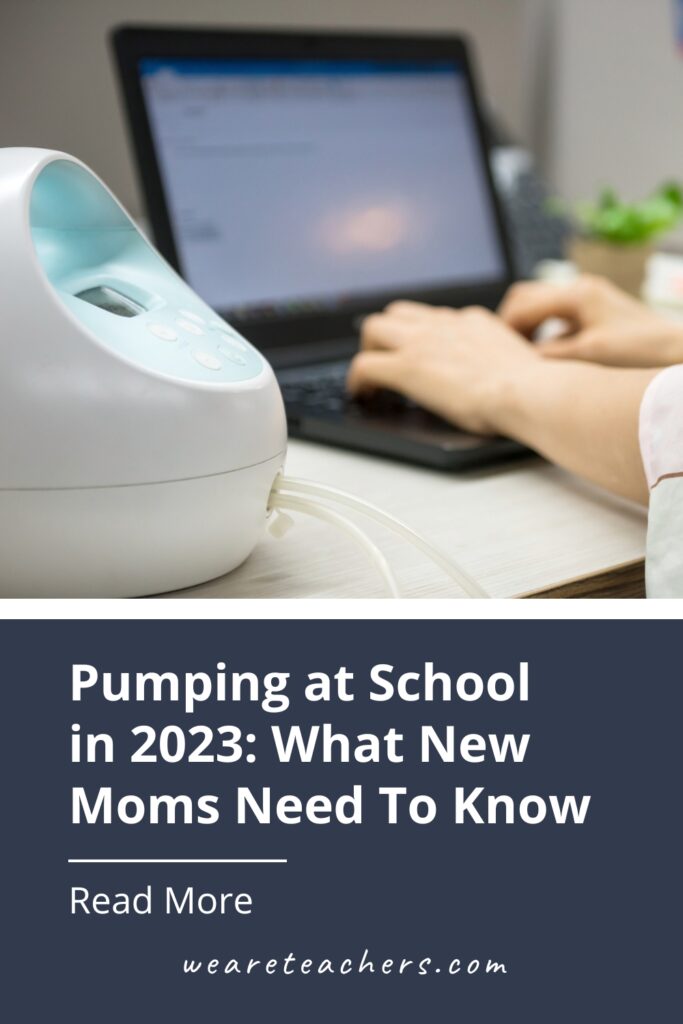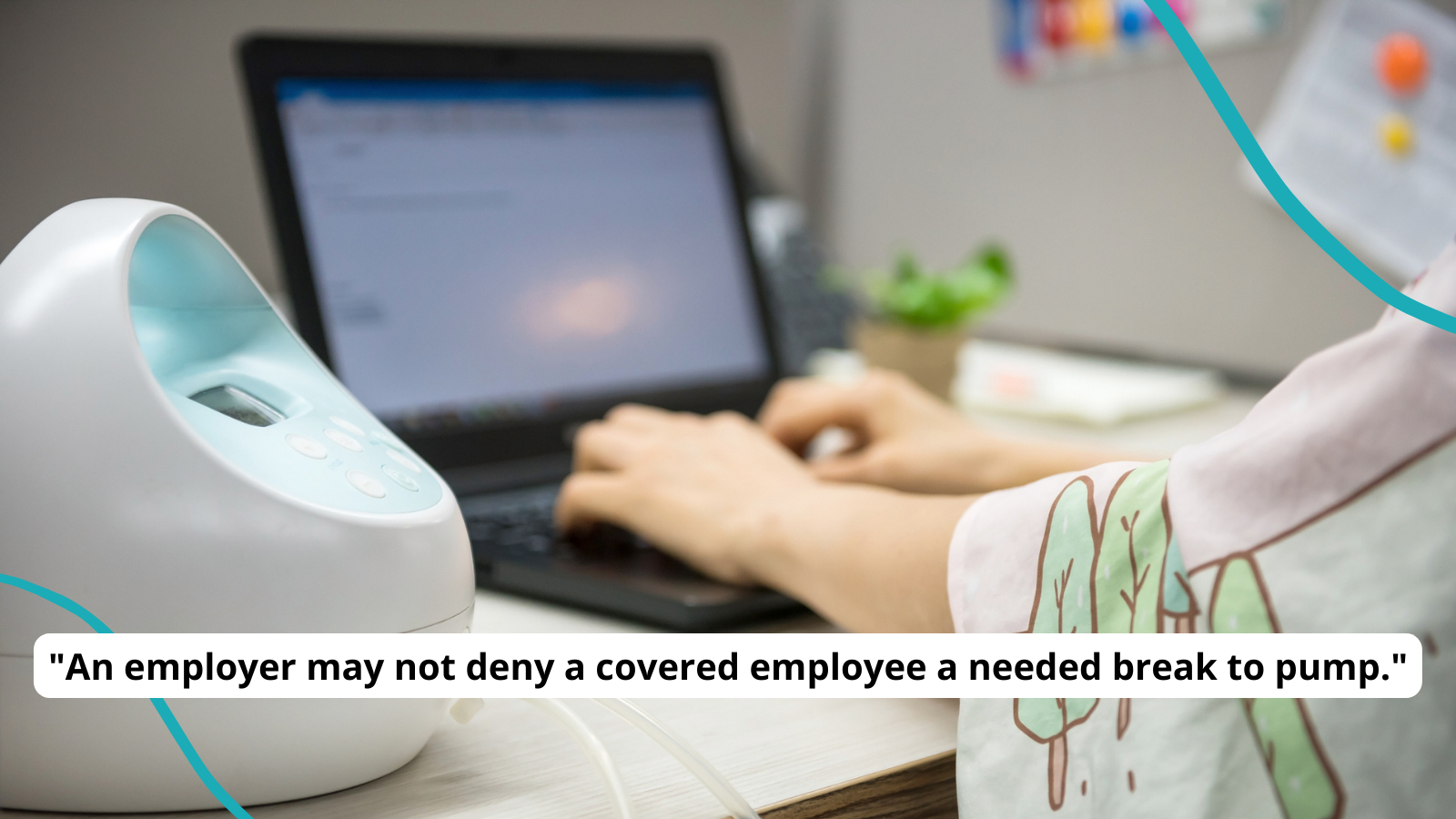With a teacher workforce that’s overwhelmingly female, it’s no surprise that many of them are working moms. New moms face special challenges when they return to work, especially if they’re breastfeeding. Most experts agree that breastfeeding is good for babies and moms, and more than 82% of new moms at least give it a try. By 6 months, over half of moms are still breastfeeding, and more than a third still are at 1 year old. Most women feed their babies or express milk every 2 to 3 hours. All of this can be challenging enough at home, but what about for working moms? Here’s what teacher moms need to know about pumping at school.
Know your rights.

The international symbol for breastfeeding, often displayed on signs outside lactation rooms.
First, know your school’s legal obligations in providing space and time for you. The United States has made a concerted effort in recent years to make it easier for working moms to pump. On December 29, 2022, President Biden signed the Consolidated Appropriations Act, 2023, into law. The law includes the PUMP for Nursing Mothers Act (“PUMP Act”), which extends more rights to nursing employees, including teachers.
If you’re not sure about your rights, ask. “My coworker who gave birth a year before me pumped all school year in the woman’s staff bathroom because she did not know her rights to be supplied with a room that is not a bathroom,” says Gina F. Employers might not make accommodations unless you ask.
Plan in advance.
Once you know what your rights are, start planning. Give some serious thought to what you have the right to as well as what you need to feel comfortable pumping at school. A good starting place is the PUMP Act requirements that specify employers must provide:
- For one year after the child’s birth, covered employees may take reasonable break time “each time such employee has need to express the milk.”
- Employees must have “a place, other than a bathroom, that is shielded from view and free from intrusion from coworkers and the public, which may be used by an employee to express breast milk.”
You can certainly suggest pumping locations to your administrator, but at the end of the day it’s their job to secure a space that is private and free from intrusions, and it cannot legally be a bathroom. Some teachers lock their classroom and hang up a Do Not Disturb sign. Others go to an alternate space, like a closet or book room.
Your school is responsible for keeping your space free for you to express milk, even if that space is used for other activities throughout the day.
It’s not required, but I would request a space with an electric outlet and, ideally, a sink. Washing your pump parts in a science sink while 28 middle school students look on is, uh, an experience. In an ideal world, we’d have a room dedicated for pumping employees with all of this plus a refrigerator for milk. Sigh. A girl can dream.
Think about your schedule.
Think about how often and at what time you usually feed—those will be the best times for you to pump during your school day. Most women need to pump two or three times during the working day, but the duration and frequency will vary from person to person. But also know this:
- An employer may not deny a covered employee a needed break to pump.
- You don’t have to use your lunch or break time.
And while the law guarantees a “reasonable” amount of time that is subject to interpretation, it also has a stipulation that the steps surrounding what’s required to pump should be taken into account. Walking across campus, setting up your pump, washing supplies, bagging milk, and putting it in the nearest refrigerator—this all adds time.
Staff and admin cooperation is key in making sure you have adequate coverage during your pump times, especially on days when the school is on a different schedule. Try to accommodate and thank people who help provide coverage, but don’t feel guilty—this is your time by law.
If you feel intimidated trying to plan your pump times, a breastfeeding consultant can help you navigate timing as well as provide you with language for staff or administrators you’ll need support from.
Prep your space.
If your pumping location is a real bummer like a book room or closet, don’t worry. There are plenty of ways you can make the space more homey and inviting. You will pump better if you’re relaxed—it’s science!
- Bring a lamp for a break from the harsh overhead lights.
- Have a comfy chair close to an electrical outlet.
- Make sure there’s a flat surface nearby for your pump, bottles, etc.
- Bring a phone charger, headphones, sound machine, or other tools to help you decompress.
- If your space is reserved for just your use, keep a Sharpie (for labeling bags), a roll of paper towels, wipes, and hand sanitizer there (fewer things you have to transport).
- While nothing is better to stimulate milk production than the presence of your baby, you can trick your body into maximum production mode by looking at pictures or videos of your baby, or by smelling an item of your baby’s clothing.
Related: I think a “let’s decorate/stock the pumping area” is a FABULOUS alternative to a baby shower.
Ask for what you need.
Once you know what you’ll need and have some general suggestions in mind, it’s time to talk to your administration and co-workers. Because teacher schedules aren’t particularly flexible, you’ll need support to fit in several pumping breaks each school day.
“A fellow grade-level teacher had to pump at school this past year,” one teacher observed. “The three of us at our grade level just worked it out so she could pump during recess and the other teacher and I would stay out with the kids during recess every day instead of taking turns. It worked perfectly.”
It’s important that you don’t hesitate to address this issue. Some women worry that expressing milk is too private or embarrassing to talk about with others, especially men. Bear in mind that what you’re doing is natural and healthy, and don’t be afraid to talk about it openly. In fact, the more we talk about, the more comfortable people will become with the topic. What better place than a school to help educate others?
Accept the challenges.
Know that pumping at school requires significant prep and logistical work. It can take some finagling to find a rhythm that works—and just when you find it, you’ll inevitably launch into standardized testing where no two days are the same. But knowing your rights can help make you confident in the choice you’re making for yourself and your baby.
Advocate for yourself.
If your right to pump at work has been violated or if you’ve experienced retaliation for asserting your rights, you may be able to file a lawsuit under the Fair Labor Standards Act (FLSA). You can also ask questions or file a complaint in person at any U.S. Department of Labor Wage and Hour Office or by phone using their toll-free help line at 1-866-4USWAGE. If you are deaf, hard of hearing, or have a speech disability, please dial 7-1-1 to access telecommunications relay services.
Do you have experience pumping at school? Share your tips and stories in the comments.
Plus, for more articles like this, be sure to subscribe to our newsletters.


